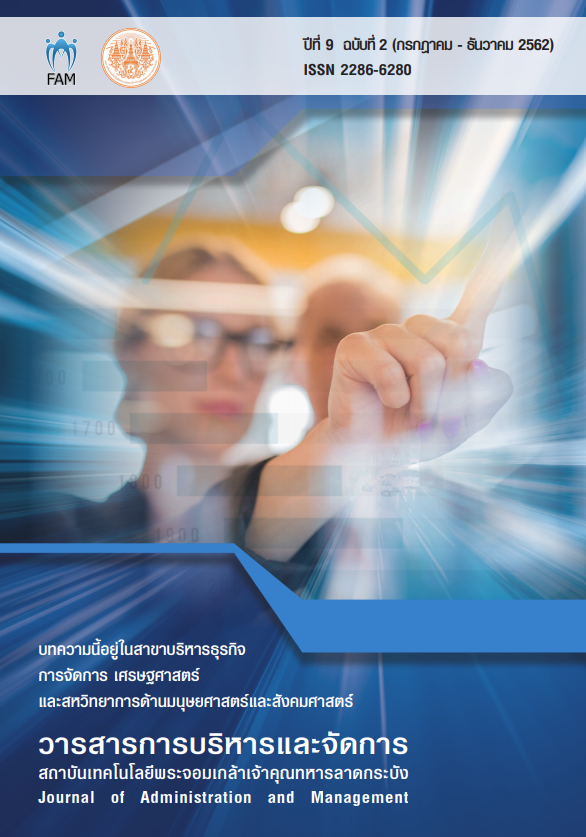MARKETING FACTORS AFFECTING MIRRORLESS DIGITAL CAMERA BUYING DECISIONS OF CUSTOMER IN THE CENTRAL REGION
Main Article Content
Abstract
The objectives of this research were to study the relationship between marketing factors affecting mirrorless digital camera buying of customers in the central region and to compare the level of opinions towards marketing factors affecting mirrorless digital camera buying of customers in the central region which was divided by personal factors. The Sample group included consumers aged between 20-50 years old, 400 people using the purposive sampling method by selecting specific consumers who used to buy and use a mirrorless digital camera and living in the central region. The instrument for collecting data was questionnaires. The statistical data were analyzed by descriptive statistics including frequency, percentage, mean and standard deviation, test and inferential statistics consisting, the hypothesis testing with statistics Independent samples t-test, One-Way ANOVA, LSD and Chi-Square. The hypothesis testing found that customers with different gender, marital status, and occupation had different opinions on products with statistical significance at 0.05. Customers with different gender and marital status had different opinions on the price with statistical significance at 0.05. Customers with different gender, marital status, and monthly income had different opinions on the distribution channel with statistical significance at 0.05 for customers with different ages, marital status and the monthly income that had different levels of opinions on marketing promotion with statistical significance at 0.05. The behavior of buying a mirrorless digital camera was found that the objective of buying a camera was related to gender, age, occupation and monthly income with statistical significance at 0.05. The budget for buying a camera was related to gender, age, education level and monthly income with statistical significance at 0.05. Source of camera purchase in the shopping mall was related to gender, age, marital status with statistical significance at 0.05. Source of camera purchase on the website was related to gender with statistical significance at 0.05 and digital camera store selling via group or page on Facebook was related to gender and age with statistical significance at 0.05. The previous buying a camera was related to gender, age, and marital status with statistical significance at 0.05. Influencers who had an influence on the buying decision of a camera were divided into self was related to gender and family/ relatives were related to the average monthly income and friends or acquaintances were related to gender, age and marital status with statistical significance at 0.05. The product presenter was related to the average monthly income with statistical significance at 0.05 and famous persons were related to marital status with statistical significance at 0.05
Article Details
Journal of KMITL Business School is available both online and in printed version.
**All articles or opinions presented in this issue of the Journal of KMITL Business School reflect the thoughts of their respective authors. This journal serves as an independent platform for a variety of viewpoints. Authors bear full responsibility for the content of their articles.**
**All articles published in this journal are copyrighted by KMITL Business School, King Mongkut's Institute of Technology Ladkrabang. The editorial team permits copying or using articles, but a reference to the journal is required.**
References
ฉัตยาพร เสมอใจ. (2550). พฤติกรรมผู้บริโภค. กรุงเทพฯ: ซีเอ็ดยูเคชั่น.
บุญชุม ศรีสะอาด. (2556). วิจัยเบื้องต้น. พิมพ์ครั้งที่ 9. กรุงเทพฯ: สุวีริยาสาส์น
ปรมะ สตะเวทิน. (2546). การสื่อสารมวลชน: กระบวนการและทฤษฏี. กรุงเทพฯ: ภาพพิมพ์
พิภพ เจริญชุษณะ. (2550). ส่วนประสมทางการตลาดที่มีผลต่อการตัดสินใจซื้อกล้องดิจิตอลของผู้บริโภค ในเขต กรุงเทพมหานคร. วิทยานิพนธ์บริหารธุรกิจมหาบัณฑิต สาขาบริหารธุรกิจ มหาวิทยาลัยเกษตรศาสตร์.
ราช ศิริวัฒน์. (2560). แนวคิดและทฤษฎีเกี่ยวกับ พฤติกรรมของผู้บริโภค. สืบค้นเมื่อ 5 มีนาคม 2562. จาก https://doctemple. wordpress.com/2017/01/23/บทที่-2-แนวคิด-ทฤษฎี-และงา/
ศิฎาภรณ์ ธรรมศรี และศรัญญา กันตะบุตร. (2559). ส่วนประสมทางการตลาดที่มีผลต่อผู้บริโภคเจอเนอเรชั่นวาย ใน จังหวัดเชียงใหม่ ในการซื้อกล้องถ่ายภาพดิจิตอล. วารสารบริหารธุรกิจ มหาวิทยาลัยเชียงใหม่, 2(3), 696-713.
ศิริลักษณ์ สุวรรณวงศ์. (2557). สถิติศาสตร์. กรุงเทพฯ: ซีเอ็ดยูเคชั่น.
ศิริวรรณ เสรีรัตน์. (2541). กลยุทธ์การตลาดและการบริหารการตลาด. กรุงเทพฯ: ศ. เสรีรัตน์.
ศิริวรรณ เสรีรัตน์ และคณะ . (2541). การบริหารการตลาดยุคใหม่. กรุงเทพฯ: ธีระฟิล์มและไซเท็กซ์.
พงศกร สิวรรณภา. (2562). กล้อง Mirrorless กับกล้อง DSLR: แนวทางที่จะช่วยคุณตัดสินใจว่ากล้อง ชนิดไหน เหมาะกับคุณ. สืบค้นเมื่อ 5 มีนาคม 2562. จาก https://yotyiam.com/ กล้อง- mirrorless-กับกล้อง-dslr/.
ศันสนีย์ ประกอบธรรม. (2559). ปัจจัยที่มีอิทธิพลต่อการเลือกซื้อสินค้าประเภทกล้องถ่ายภาพดิจิตอลของกลุ่ม วัยคนทำงานคนไทยและคนอาเซียน. สารนิพนธ์บริหารธุรกิจมหาบัณฑิต สาขาวิชาการจัดการธุรกิจโลก วิทยาลัยพาณิชยศาสตร์ มหาวิทยาลัยบูรพา.
Kotler, P. (2003). Marketing Management (11th ed.). New York: Prentice-Hall.
Marketeeronline. (2559). เมื่อเสียงชัตเตอร์กล้อง Mirrorless ดังกว่า DSLR. สืบค้นเมื่อ 5 มีนาคม 2562. จาก https://marketeeronline.co/archives/21460.


